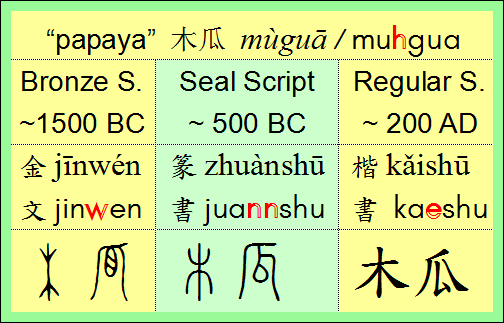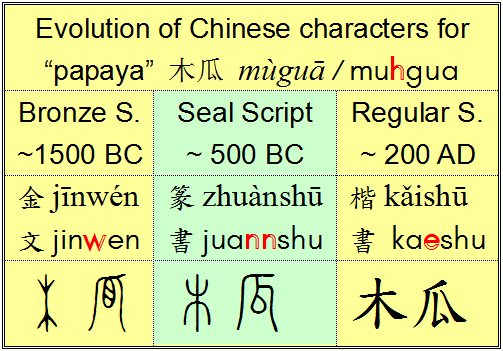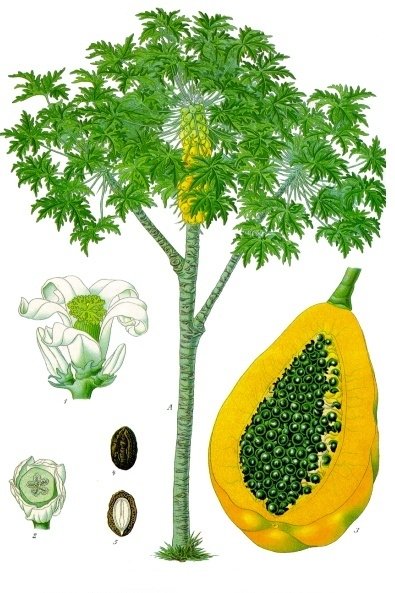Papaya (mùguā / muhgua) in Chinese literally means “tree melon”

Apart from 木, 瓜 and a few hundred other drawings of real things (pictograms), most Chinese characters are meaning-sound compounds.
Meaning & Sound Compounds
These account for most Chinese characters: one part provides a general meaning (“female, plant, fish” etc.) and the other part is a rough guide to the pronunciation (the fancy technical term is "Semanto-phonetic compounds"). Some characters date from thousands of years ago, so their pronunciation has changed a great deal since their initial creation.
Graphic Evolution of 木 and 瓜 (pictograms)
The character 木 mù / muh started out 3000+ years ago as a simplified picture of a tree. The Bronze Script form (from about 1500 BC) shows the trunk, the leaves at the top and the roots at the bottom. A thousand or so years later, this picture had evolved into a more artistic but less recognizable shape with two ovals standing in for the leaves and the roots.

The character 瓜 guā / gua started out in Bronze Script as a simplified but more easily recognizable picture of a gourd/melon hanging in the middle of a vine. The Seal Script form is an elegant, but highly stylized picture; the Regular Script form dating from ~2000 years ago is completely unrecognizable.
These two characters put together, 木瓜 mùguā / muhgua, mean papaya. In Modern Chinese, 木 means wood, but in Classical Chinese it means tree. The two-character compound 木瓜 means “papaya” ([literally] “tree melon”) because it grows on a type of tree

[Public Domain Image]
Romanization Notes
Notice that this posting provides two different spellings for Mandarin Chinese words:
(1) Hanyu Pinyin (the 1958 Chinese government standard with hard-to-type tone, hard-to-remember tone diacritics): āēīōūǖ, áéíóúǘ, ǎěǐǒǔǚ, àèìòùǜ
(2) Gwoyeu Romatzyh (the 1928 Chinese government standard with intuitive, easy-to-remember mnemonic tone spellings; after the slash)
Most red letters in GR do double duty: they stand for consonants and vowels simultaneously. The hollow portion is a mnemonic that helps foreign students remember either the pitch change or the vowel length.
If you liked this post, you might also like these:
https://steemit.com/cn/@wentong-syhhae/chinese-for-false-beginners-a-thinker-s-approach
https://steemit.com/cn/@wentong-syhhae/the-tyranny-of-chinese-spelling-the-passionfruit-case
https://steemit.com/cn/@wentong-syhhae/chinese-easy-to-learn-but-a-good-foundation-is-needed
Who I Am
https://steemit.com/introduceyourself/@wentong-syhhae/enthusiastic-intp-polyglot
I don't know a thing about the Chinese language or culture to be honest..
But it's interesting to see the progression of something over time as the centuries creep on!
It's funny to see on the second character how the little lined loop in the middle lowers, then turns into a somewhat "L" shape by the final form!
Crazy just how much change happens! :P
Thanks for following me and helping support my service! :P
I have resteemed this post and have your 2nd resteem on hold!
- The Duchess
What a thoughtful, encouraging comment!
I write posts about Chinese only to help people get to know (and perhaps learn) this marvelous language. A dollar or two is always welcome, but I would be very hungry indeed if I depended on my posts to earn enough to pay for my meals. What I truly treasure are intelligent, perceptive comments such as yours and the sense of community.
Thank you, @duchess1, for promoting community feeling through this human resteem service. It was thanks to your resteems that I noticed an inadvertent error by @neelamnaz that made her all-important introductory post almost invisible. Although I am not an expert, I have given her a few suggestions to point her in the right direction:
https://steemit.com/intriducingmyself/@neelamnaz/about-myself#@wentong-syhhae/re-neelamnaz-about-myself-20180126t042000482z